Abstract
Internet of Things (IoT) technology is rapidly transforming various industries. Advancements in production technologies have made it more affordable to produce suitable hardware to create IoT-based systems. This has resulted in a wide range of options available at reasonable prices. Having multiple options available gives designers creative freedom. However, having more options may confuse designers and make it more difficult to choose hardware that meets design needs. This paper presents an expert system for IoT-based system hardware selection. In the proposed approach, the hardware information and expert knowledge are stored in a database and a knowledge base. Users input their required specifications using a user interface, and then the system’s decision-making module constructs the decision matrix and eventually ranks the alternatives utilizing a hybrid ITARA-COBRA method. Due to the ambiguity in the data, grey numbers are used for decision-making. In the next step, an example of an agricultural IoT-based system design is applied to test the system. The proposed Grey ITARA method is compared with the Grey MEREC and Grey CRITIC methods, and given the use of the indifference threshold concept, it performs well. Moreover, its ability to handle unstructured, vague data is useful for using technical specifications and expert opinions in decision-making.
1. Introduction
The Internet of Things (IoT) refers to a network of interconnected smart objects capable of processing information [1]. Industry sectors such as transportation [2] and manufacturing [3] apply IoT technology to enhance operating efficiency. The ease of access to the accompanying tools has enabled companies to develop smart IoT systems to solve real-life problems, and companies are implementing this technology to solve problems across many areas, including healthcare [4], manufacturing, and agriculture [5].
Since IoT-based systems form a vital component of Industry 4.0, the architecture of these systems is of prime importance. Choosing the right hardware for these systems forms a part of their design.
The hardware for IoT-based systems should be selected considering cost and system goals. Selecting proper hardware for computer systems is a complex issue that has been studied from various perspectives using diverse methods. Applying multi-criteria decision-making (MCDM) techniques is an effective way to handle and solve IoT-based system hardware selection problems [6].
Proper hardware selection is a structured process. First, the right experts are identified to provide data on the decision-making problem. Next, the selection criteria are determined and ranked according to expert opinion using methods such as BWM, SWARA, or ITARA. Subsequently, hardware options are assessed and ranked against these criteria using techniques such as COPRAS, EDAS, TOPSIS, VIKOR, or COBRA. Lastly, the selected hardware should comply with the purpose of the system, given the varied objectives and design specifications of existing products.
It is not possible to select hardware for all IoT systems based on just a single decision-making model. Instead, the system must retain and keep hardware information and expert knowledge current. An expert system is one very useful way of doing that.
Expert systems possess expert knowledge and relevant data that apply to the problem [7]. The knowledge includes selection criteria, their relative significance, and how far each alternative meets these criteria. The stored data can vary from technical specifications, like processing power, to non-technical data, like cost. MCDM methods have also been used in expert systems in past research [8].
By interacting with the user, the system can understand certain requirements and needs. To prescribe the requisite hardware, the expert system also needs to figure out what components the user’s system requires. Once one understands the decision-making problem, they should be able to categorize and organize the available hardware options.
The main goal of this research is to address the challenge of selecting proper components for IoT-based systems. This research develops an expert system that integrates user needs and expert knowledge. The criteria are weighted using the indifference threshold-based attribute ratio analysis (ITARA) method, which allows unstructured information to be processed by defining indifference thresholds and considering entropy [9]. These capabilities make it possible to use both technical specifications and expert opinions in constructing a decision problem. Finally, the comprehensive distance-based ranking (COBRA) [10] method is utilized to rank alternatives. Furthermore, grey numbers are applied to manage uncertainty by allocating interval values for vague parameters [11]. This makes it possible to handle uncertainty present in parameters and linguistic terms effectively. The study explores the following issues:
- Q1: How can an expert system be designed to select the best hardware from the available alternatives?
- Q2: Can the grey number approach be combined with the hybrid ITARA-COBRA method? How can this methodology help decision-makers?
To address these questions, this research discusses the existing literature and then posits the proposed methodology and expert system architecture. It then evaluates the hybrid Grey ITARA-COBRA method through sensitivity analysis. Finally, an example of designing IoT-based systems in agriculture is provided.
1.1. Literature Review
Due to their adaptability, MCDM techniques have been applied to a wide range of decision-making problems, including urban planning, sustainable supply chain networks, and the healthcare industry. One key application of these techniques is component selection for system design.
Given the ease of developing such systems, MCDM methods are also widely used in hardware selection for computer system design. A notable example is IoT-based systems, which consist of sensors, processors, power supplies, and communication devices. As cyber-physical systems, IoT-based solutions require both appropriate system software and carefully chosen hardware components. Depending on the specific hardware selection challenge, researchers have applied MCDM techniques to identify the most suitable components. Table 1 summarizes studies that apply MCDM techniques for selecting computer system components, hardware, and devices.

Table 1.
Use of MCDM to select appropriate components in computer systems design and device selection.
1.2. Research Gap and Contributions
In previous sections, the problem and the related literature were investigated. In general, three challenges must be addressed to solve the IoT-based hardware selection problem:
- Different alternatives, criteria, and criterion weights for different systems, like agricultural and workplace systems;
- Vagueness and impreciseness in the existing data, like the accuracy of sensors;
- Unstructured data for decision-making, for example, the presence of linguistic terms from experts alongside technical specifications.
The main goal of this research is to design an expert system covering these challenges. One possible solution to the first challenge is to use an expert system. In this type of system, it is possible to use a database and a knowledge base to store data and expert opinions. Then, the system can structure the decision problem based on the needs of the user and the specifications of the desired system.
For the second challenge, grey sets offer a viable approach to handling uncertainty. Grey sets use grey interval values with no precisely known membership values. Not only can grey intervals be applied to linguistic terms, they also address ambiguity in several attributes such as sensor accuracy, power consumption, and durability.
In different problems that are solved using MCDM techniques, there can be different criteria, and each criterion has its own weight, which must be determined by experts. There are different methods for determining the weight of criteria, such as the analytic hierarchy process (AHP) method and the best–worst method (BWM), which are among the well-known methods. The AHP method performs weighting based on pairwise comparisons. Experts must perform these comparisons verbally. Given the ambiguity in some data, the fuzzy AHP approach has also been developed, and applications have been found in various fields, from power systems to supply chains [31,32]. The BWM method has also been used in a variety of contexts, from supply chain management [33] to evaluating healthcare sectors [34]. In this method, the most important (Best) criterion is compared in pairs with other criteria, and each criterion is compared in pairs to the least important (Worst) criterion. It is worth noting that fuzzy [35] and grey [36] implementations of this method have also been presented to handle ambiguity in data. These methods are subjective, which means that they require experts’ linguistic assessments for weighting, and they cannot calculate weights based on numerical data. In these methods, scores are determined based on subjective ratings of criteria from experts. However, in some decision problems, weighting and decision-making may need to be based on numerical data. A new method for determining the weight of criteria is the ITARA method, which can be useful when the data are unstructured. This means that this method can handle both subjective terms and numerical data. ITARA has been used for various issues in transportation, production, material selection, and risk assessment, and in some cases, its fuzzy implementation has also been used. In this method, the entropy of the data is calculated, and the weight of each criterion is determined based on the criterion’s indifference threshold. Considering these cases, ITARA can be used to cover unstructured data.
None of the articles related to IoT hardware selection have utilized the ITARA technique, but its capability to cover unstructured data can help decision-makers make appropriate decisions based on numerical data, like price and processor speed, and linguistic terms based on expert comments. Also, for the first time, the Grey ITARA technique is utilized here. The Grey ITARA technique gives us the ability to handle uncertain data. In the software selection problem, decision-makers must handle imprecise linguistic terms and engineering data that may not be precise enough. In these conditions, the proposed Grey ITARA technique can handle both uncertain and unstructured data. In addition to weighting, a ranking method must be used to rank the existing alternatives. One of the recently developed methods to rank the alternatives is the COBRA method, in which the Euclidean and the Taxicab distances from the best, worst, and average solutions are measured to rank the alternatives. Generally, the capability of the proposed Grey ITARA–Grey COBRA method to handle imprecise and unstructured data is investigated. The research hypothesis is that the proposed Grey ITARA-COBRA method can be useful for weighting criteria and ranking alternatives when designing engineering systems such as IoT-based systems. In these problems, decision-makers must utilize methods that can cover both expert opinions and the existing vague data.
In this paper, an expert system is introduced to help developers select suitable hardware for IoT-based systems. The provided system uses a database and a knowledge base to achieve its goals. The provided system extracts data from the database and a knowledge base to construct the decision matrix based on the desired IoT-based system specifications and solves the decision-making problem with the Grey ITARA-COBRA method to handle unstructured and vague data.
The contributions of this paper are as follows:
- Designing an expert system capable of handling engineering data and expert knowledge to support users.
- Utilizing Grey systems theory to enhance the ITARA method.
- Using the Grey ITARA-COBRA approach to handle imprecise and unstructured data (expert opinions and imprecise numerical data).
2. Materials and Methods
This study examines the feasibility of using an expert system to select suitable hardware for developing IoT-based systems. This section discusses the research methodology, which includes the desired expert system and its decision-making module.
2.1. Expert System Design
The proposed system is designed with a knowledge engineering approach and consists of an expert interface section, a user interface, a knowledge base, a database, and a decision-making module. In this approach, expert knowledge is used alongside available numerical data to assist the user.
In general, the system has two inputs, which are as follows:
- The expert interface: This is the component where expert opinions, including scores on various components and the expert’s criteria, are entered into the system.
- The user interface: The user interface is the part where the user enters their needs and must answer related questions, based on which the system’s goals must be determined. These questions regarding the systems may vary case by case.
Also, this system uses a database and a knowledge base to store the existing data and knowledge:
- Database: This is the component where hardware information is stored. Technical and economic information, like power consumption and price, is stored in a database. The database is also linked to the expert interface, which allows for the sharing of technical data with experts.
- Knowledge base: The knowledge base is where expert knowledge is stored. The expert ratings are stored in this component.
Finally, the core of this system is its decision-making engine:
- Grey ITARA-COBRA engine: This module first determines the system’s required components based on the user’s input data. The determination of these items, like the questions asked of the user in the user interface section, can vary depending on the system the user is designing. After the required tools for the system are determined, the decision-making module obtains information about the hardware that can be utilized from the database. This module also obtains the opinions of experts from the knowledge base. Finally, if there is more than one option for selecting hardware, it selects the required hardware using the Grey ITARA-COBRA method.
The model of the designed expert system is depicted in Figure 1.
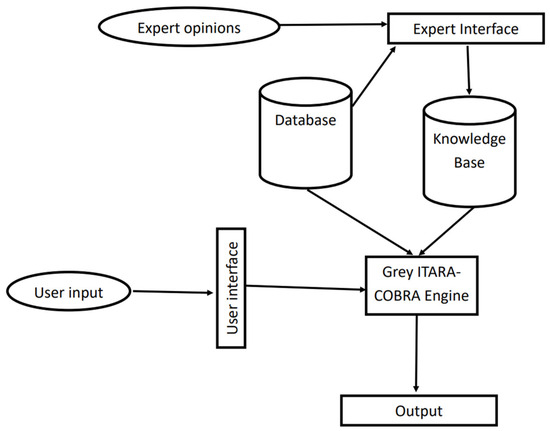
Figure 1.
Proposed expert system structure.
2.2. Decision-Making Engine
This module is the core of the system and is utilized to select different hardware. The system will initially fetch possible hardware options from the database and expert opinions from the knowledge base based on the needs that have been presented by the user in the interface. The system then employs the fetched information to create a decision matrix and ranks the available alternatives using the proposed Grey ITARA-COBRA technique.
2.3. Methodology
2.3.1. Grey Numbers Theory
Grey systems theory is a mathematical concept widely used in decision theory, which is used to cover ambiguity in data. According to this concept, an interval is considered for the parameters in which uncertainty exists.
A grey number is defined as follows [11]:
A crisp number is converted to a grey interval as follows:
The addition of two grey numbers is as follows [11]:
The subtraction of two grey numbers is performed with the following formula [11]:
The multiplication of two grey numbers is performed with the following formula [11]:
The division of two grey numbers is as follows [11]:
The center of a grey number is defined as follows:
The length of the grey interval is obtained with the following formula [11]:
2.3.2. ITARA Method
The steps of the ITARA weighting method, presented by Hatefi, are as follows:
Initially, a decision matrix is constructed consisting of n alternatives and m criteria. Also, the indifference threshold is specified for each criterion, which is displayed with [9].
In the next step, using Equations (9) and (10), the decision matrix and indifference threshold of each criterion are normalized [9].
In the next step, the normalized scores are sorted in order, and is obtained in such a way that .
Let be ordered distances between adjacent and [9].
Then, the considerable difference between and is defined as Equation (11) [9].
Finally, the weights are obtained as follows in Equation (12) [9]:
where
2.3.3. COBRA Method
COBRA is a method for ranking alternatives in decision-making problems. The steps of this method are as follows.
Initially, as in the ITARA method, the decision matrix is determined.
In the next step, this matrix is normalized [10].
where
Then, a weighted normalized matrix is constructed [10].
where is the relative weight of criterion j [10].
For each criterion function, the positive ideal (), negative ideal (), and average solution () are determined in the following way [10]:
where B is the set of benefit criteria and C is the set of cost criteria.
For each alternative, determine the distances from the positive ideal () and negative ideal () solutions, as well as the positive () and negative () distances from the average solution as follows [9]:
where represents any solution (, , ) [9].
is obtained as follows [10]:
For the positive ideal solutions, the Euclidean and Taxicab distances are obtained in the following way [10]:
For the negative ideal solutions, the Euclidean and Taxicab distances are obtained in the following way [10]:
For the positive distance from the average solution, the Euclidean and Taxicab distances are calculated as follows [10]:
Finally, for the negative distance from the average solution, the Euclidean and Taxicab distances are calculated in the following manner [10]:
The alternatives are ranked according to the increasing values of the comprehensive distances () obtained using the following [10]:
2.3.4. Proposed Grey ITARA-COBRA Method
In many MCDM approaches, such as AHP and BWM, weighting is performed subjectively based on expert opinions, typically expressed using linguistic terms. On the other hand, some decision-making problems require weighting and ranking to be based on both numerical data and expert opinions, for which objective methods like ITARA are employed. However, in many cases, data may not be available in a precise form, and the presence of ambiguity complicates the decision-making process.
In this study, the grey number approach is used to address ambiguity in the data and the opinions of experts. The aim of this work is to enhance the capabilities of the ITARA method. The use of grey numbers allows the ITARA method to handle ambiguity and imprecision in the data, enabling it to cover ambiguous data in addition to unstructured data. Moreover, by considering the possibility of using numerical data alongside verbal expert opinions, it becomes a suitable method for engineering applications.
The proposed Grey ITARA-COBRA approach combines the ITARA and COBRA methods using the grey number application. Weights are first calculated using the Grey ITARA method, and then the results are input into the Grey COBRA method.
The use of grey number operators necessitates a modification of the normalization method. Normalization is initially performed using Equation (35).
The post normalization procedure the same as that for the ITARA method, except that grey number operators are used during these steps. Unlike the ITARA method, data are used in a grey form at every stage. Since grey numbers are used in all steps, the criterion weights are also derived as grey numbers. It is worth noting that grey weights can be converted to crisp numbers to make them understandable, but since grey numbers are also used in the ranking step when ranking is performed using the grey COBRA method, the grey weights are directly given as input to the COBRA method.
As mentioned, the Grey COBRA method is used to rank the alternatives. Given that the output of the Grey ITARA method provides weights in grey form, the proposed Grey COBRA approach must be capable of accepting these grey weights as input. Furthermore, due to the presence of ambiguity in the data, the method should receive the decision matrix in a format similar to that of the Grey ITARA method and perform calculations using grey number operators. The use of the grey number approach enables the method to handle existing ambiguity effectively. In addition, this research investigates the capability of the Grey COBRA method to handle unstructured data.
Normalization in the proposed Grey COBRA method is carried out using Equation (35). In order to perform the proposed Grey COBRA method calculations, due to the use of grey numbers, grey mathematical operators are used to ultimately derive grey scores. Finally, the centers of grey scores are derived from Equation (7), and alternatives are ranked in ascending order based on their scores.
In general, the proposed Grey ITARA-COBRA approach has a similar procedure to the ITARA and COBRA methods. However, in this method, grey numbers are used to cover ambiguous data, and the grey operators are used instead of the mathematical operators of crisp numbers. Also, its normalization steps are modified according to the grey operators. In general, the proposed approach is presented to cover unstructured data (including numerical data and verbal opinions of experts) and handle the existing vagueness in the data so that it has suitable applications in various fields, such as engineering applications.
2.3.5. Sensitivity Analysis of the Proposed Grey ITARA-COBRA Method
In this section, a sensitivity analysis was conducted on the proposed Grey ITARA-COBRA method. A decision matrix was constructed with three criteria and three alternatives to perform the sensitivity analysis, and the weights were calculated. First, the impact of the change in grey scale length was investigated. As depicted in Figure 2, the criterion weight decreases with an increase in grey interval length.
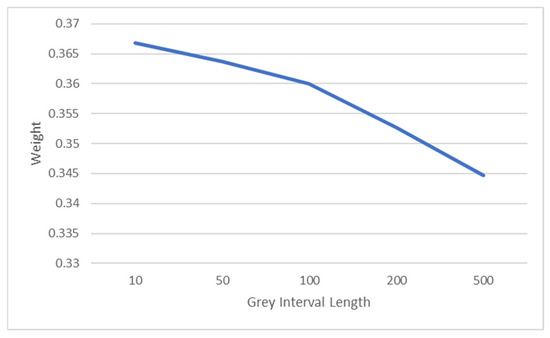
Figure 2.
Impact of grey interval length on C1 weight.
The first thing to consider for sensitivity analysis is the length of the grey intervals. The shorter the grey intervals are, the less ambiguity there is in the data. To analyze the sensitivity of the weights to grey interval length, five instances with different lengths for criterion C1 are created. In these instances, the centers of the grey numbers for the alternatives are 1000, 2000, and 3000, respectively. The alternatives have the same scores based on the second and third criteria, and therefore, it is expected that the weights of the second and third criteria (C2 and C3) are the same. On the other hand, the first criterion is variable, and the effect of the length of the grey number interval can be measured by examining the changes in the weight of the first criterion (C1). The length of the intervals in different instances is set to 10, 50, 100, 200, and 500, which includes small intervals and large intervals in comparison to the scores of the alternatives. The data are listed in Table 2.

Table 2.
Instances with different lengths for criterion C1.
The indifference threshold is equal to 100 for criterion C1, 200 for C2, and 200 for C3. The impact of the change in grey interval length on C1 weight is depicted in Figure 2. As is clear, as the length of the grey interval increases, the weight of the C1 criterion decreases. Moreover, in all instances, criteria C2 and C3 have equal weights.
In addition, the impact of the entropy and indifference threshold is analyzed. Five different sets with different entropies for criterion C1 are created. In these instances, the lengths of the grey intervals are the same, and similar to the previous analysis, the alternatives have the same scores based on criteria C2 and C3, and these criteria are expected to have the same weights. The effect of entropy on the weight of criterion C1 is also examined. In the first entropy set, the variation in the data is small, and the alternatives have similar scores. However, gradually, the variation between the values of the alternatives increases in comparison to each other. The instances are listed in Table 3.

Table 3.
Instances with different entropies.
Based on the analysis carried out, the criterion weight increases with an increase in entropy. The changing weight of C1 for different entropy sets and the third indifference threshold set are depicted in Figure 3. Similar to the previous analysis, the criteria C2 and C3 have equal weights.
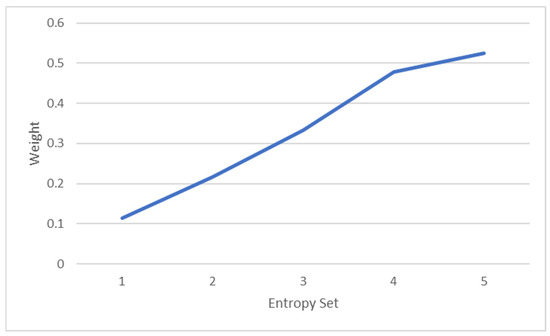
Figure 3.
Impact of entropy on C1 weight.
Also, the impact of change in the indifference threshold is analyzed. Five instances with same scores but different indifference thresholds for C1 were created. In general, it is expected that as the indifference threshold increases, the weight of the criterion decreases because the level of indifference to the alternatives has increased. Also, criteria C2 and C3 have similar indifference thresholds and are expected to have the same weights. The instances are listed in Table 4.

Table 4.
Different indifference thresholds for sensitivity analysis.
As expected, criterion weights decrease with an increase in the indifference threshold. The changing weight of C1 for different indifference threshold sets and the third entropy set are depicted in Figure 4. Similar to previous analyses, the weights of criteria C2 and C3 were equal to each other.
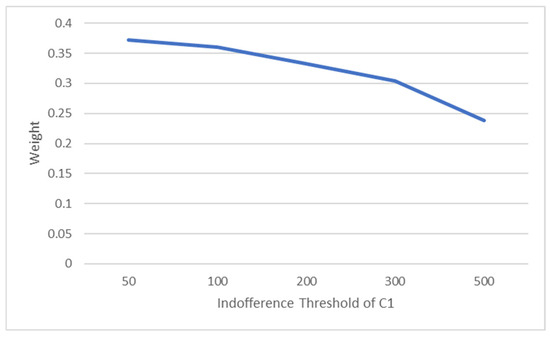
Figure 4.
Impact of change in indifference threshold on C1 weight.
Moreover, a two-way sensitivity analysis was conducted to investigate the impact of simultaneous changes in the indifference threshold and the entropy. For this purpose, each combination of entropy sets and indifference thresholds was considered as an instance. Figure 5 depicts the impact of simultaneous changes in the indifference threshold and the entropy on C1 weight.
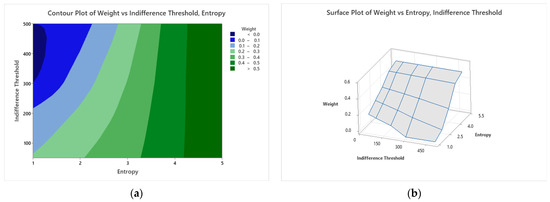
Figure 5.
(a) Contour plot of the impact of simultaneous changes in the indifference threshold and the entropy on C1 weight; (b) surface plot of the impact of simultaneous changes in the indifference threshold and the entropy on C1 weight.
As illustrated in Figure 5, increasing entropy increases the weight of the criterion, and increasing the indifference threshold decreases the weight of the criterion. In Figure 5b, the vertical axis shows the weight of the C1 criterion, and the other two axes show the indifference threshold and the entropy set. Figure 5a is a contour plot of the changes in the weight of the C1 criterion against changes in entropy and the indifference threshold.
3. System Implementation and Computational Results (For IoT-Based Irrigation System Hardware Selection)
The proposed expert system was implemented using the Python 3.12.1 programming language. Expert and user inputs are entered into the system using a terminal. This section examines this implementation, focusing on the hardware selection of IoT-based systems for agricultural applications.
3.1. Agricultural IoT-Based System Hardware Selection Problem
In this section, the IoT-based agricultural systems hardware selection problem is shown as an example. To begin with, the technical specifications of the hardware available must be stored in the database. Also, the criteria identified as essential for hardware selection by the expert must be included in the knowledge base. In addition, the expert assessment is stored in the knowledge base, too. The linguistic terms are converted into grey numbers according to Table 5.

Table 5.
Converting linguistic terms to grey intervals.
As mentioned, the system uses the user’s comments entered into the user interface to identify the decision matrix. For example, suppose a user answered the following questions:
- Q1:
- What system is required? User answer: An irrigation system.
- Q2:
- What features should this system have (for example, the ability to monitor soil chemical properties, the ability to image plants to detect diseases, etc.)? User answer: Irrigation, based on soil moisture level.
- Q3:
- Is urban electricity available at your place? User answer: Yes. Therefore, the option of using urban electricity will be among the alternatives for choosing an energy source.
This system, like all IoT-based systems, must operate on a development platform. In addition, given the need for the system components to communicate with each other, a communication protocol is also required. Given the system’s need to measure soil moisture, a soil moisture sensor is required. Finally, it is worth mentioning that this system, like any electrical system, requires an energy source in order to operate. Based on the answers to these questions, the designed expert system understands that the irrigation system required by the user requires the mentioned components. First, the technical specifications and the opinions of the selected expert regarding the scores of alternatives in the criteria that require expert rating must be stored in the system. In this regard, a credible expert was selected. Then, using the technical specifications and expert opinions, the system forms a decision matrix. In these assessments, the exact names of the technologies and the alternatives are not given to avoid commercial influence.
3.1.1. Platform Selection
In the first step, the development platform of an IoT-based system must be selected. The decision criteria for selecting a proper platform are as follows:
- Cost: The overall cost of the IoT platform.
- Processing Power: The processing power of the IoT device (in MHz/GHz for processors and microcontrollers). The platform must be capable of processing the requested tasks.
- Current (Power Consumption): The amount of electrical current the platform consumes.
- Ease of Development: The ease of developing, programming, and integrating the platform into an IoT solution.
Cost, processing power, and current consumption are measured based on available technical data, and the ease of development is converted to a grey number based on the expert linguistic terms in Table 5. These decision criteria are summarized in Table 6. These tables show whether the criterion is a cost or benefit type, and the corresponding indifference threshold is given.

Table 6.
Decision criteria for platform selection.
The decision matrix is constructed as follows in Table 7. Note that in this table, some technical parameters are precisely known. So, the upper and lower limits of the grey numbers are equal. In this article, a lower limit of each grey number is shown with the letter L, and the upper limit of each grey number is shown with the letter U.

Table 7.
Decision matrix for platform selection.
The normalized center of grey weights for platform selection criteria are calculated as follows in Table 8. In this assessment, criterion C1: Cost is considered the most important (weight of 46.71%), and criterion C4: Ease of Development is the least important (weight of 15.54%).

Table 8.
Normalized center of grey weight for platform selection criteria.
The centers of grey scores are calculated as follows in Table 9. In this comparison, the alternatives have achieved close scores to each other, although PL4 ranked first and PL3 ranked last.

Table 9.
Rank and center of grey scores for platform selection.
3.1.2. Communication Technology Selection
IoT-based system components must communicate with each other over a network. There are different technologies for this purpose. To select the communication technology, first, the criteria are identified as follows:
- Range: The maximum distance for which a communication technology can transmit data.
- Power Efficiency: The amount of energy required for communication, impacting battery life and suitability for low-power IoT applications.
- Data Rate: The speed at which data are communicated.
All of these criteria are considered beneficial, and it is desirable to add relevant values to these criteria. These decision criteria are summarized in Table 10.

Table 10.
Decision criteria for communication technology selection.
Then, the decision matrix is constructed as in Table 11. Only the criterion C2: Power Efficiency is assessed based on expert ratings.

Table 11.
Decision matrix for communication technology selection.
The normalized center of grey weights for platform selection criteria is calculated as follows in Table 12. In this assessment, criterion C1: Range is considered the most important (weight of 61.07%), and criterion C2: Power Efficiency is the least important (weight of 16.01%).

Table 12.
Normalized center of grey weights for communication technology selection criteria.
Finally, the scores are calculated as follows in Table 13. According to the calculations, Protocol 1 has the best score and is in first place. Protocols 2, 3, and 4 have close scores, and the last place belongs to Protocol 3.

Table 13.
Rank and center of grey scores for communication technology selection.
3.1.3. Energy Source Selection
The third problem in decision-making is choosing the proper energy source. Criteria are identified as follows:
- Availability: Convenience of accessing and utilizing the energy source.
- Cost: The price of acquiring, deploying, and maintaining the energy source over time. The price of electricity per kWh is expressed in monetary units.
- Maintenance: The labor and resources required to keep the energy source operational, including replacements, repairs, and servicing.
- Sustainability: Long-term sustainability and environmental impact of the energy source.
- Reliability: Dependability and reliability of the energy source to provide continuous power to IoT devices.
The only cost criterion is C2: Cost. This information is summarized in Table 14.

Table 14.
Decision criteria for selecting an energy source.
The decision matrix is constructed as in Table 15. All of the assessments are based on expert opinions except for the cost. One note about this table is that the urban electricity alternative is available among the alternatives because the user announced its availability.

Table 15.
Decision matrix to select an energy source.
The normalized center of grey weights for platform selection criteria are calculated as follows in Table 16. In this assessment, the criteria have somewhat similar weights, but criterion C2: Cost is recognized as the most important (with a weight of 29.64%), and criteria C3: Sustainability and C5: Reliability are the least important (with weights of 13.43%).

Table 16.
Normalized center of grey weights for energy source selection criteria.
Finally, the scores are calculated as follows in Table 17. In this comparison, urban electricity has achieved the first rank. One of the reasons for this ranking is the high weight of the C1: Cost criterion and the high score of the urban electricity for this criterion due to its cheap setup. The alternative, Solar 2, also achieved the last rank.

Table 17.
Rank and center of grey scores for energy source selection.
3.1.4. Soil Moisture Sensor Selection
This system requires a soil moisture sensor to measure soil moisture. To select a proper soil moisture sensor, the criteria are first identified as follows:
- Accuracy: The sensor’s accuracy in measuring soil moisture content is typically reported as a percentage of the volumetric water content.
- Current: The degree of electrical power consumed by the sensor affects battery life and energy efficiency in IoT applications.
- Durability: The ability of the sensor to withstand environmental conditions like moisture, temperature fluctuations, and soil conditions for a period.
- Cost: The overall price of the sensor.
Criteria C1: Accuracy and C4: Cost are the cost criteria. This information is summarized in Table 18.

Table 18.
Decision criteria for soil moisture sensor selection.
Then, the decision matrix is extracted from the database and the knowledge base. Table 19 shows the decision matrix. The only criterion by which options are assessed based on expert opinion is price.

Table 19.
Decision matrix for soil moisture sensor selection.
The normalized center of grey weights for platform selection criteria are calculated as follows in Table 20. Based on the evaluations, the most important criterion is C4: Cost, with a weight of 38.00%, and the least important criterion is C1: Accuracy, with a weight of 16.19%.

Table 20.
Normalized center of grey weights for soil moisture selection criteria.
The scores are calculated as follows in Table 21. Based on assessed scores, the best alternative is Sensor 3. Sensor 1 is also a close second. Sensor 2 has the lowest score.

Table 21.
Rank and center of grey scores for soil moisture sensor selection.
3.2. Comparison of Grey ITARA, Grey CRITIC, and Grey MEREC Methods for IoT-Based Irrigation System Design
In this section, the weights from Grey ITARA are compared to the methods: Grey MEREC and Grey CRITIC. Figure 6, Figure 7, Figure 8 and Figure 9 show the weights obtained by the mentioned methods.
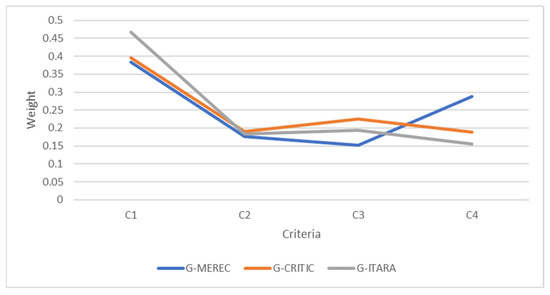
Figure 6.
Comparison of criterion weights (normalized center of grey weights) obtained by Grey ITARA, Grey CRITIC, and Grey MEREC for platform selection criteria.
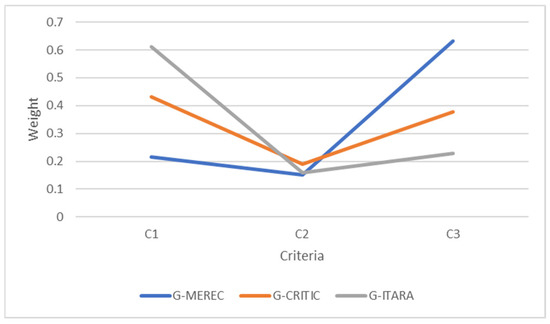
Figure 7.
Comparison of criterion weights (normalized center of grey weights) obtained by Grey ITARA, Grey CRITIC, and Grey MEREC for communication technology selection criteria.
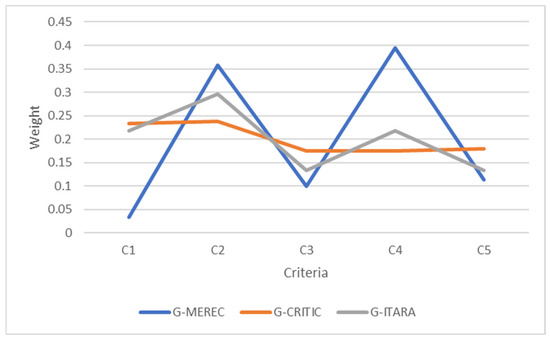
Figure 8.
Comparison of criterion weights (normalized center of grey weights) obtained by Grey ITARA, Grey CRITIC, and Grey MEREC for energy source selection criteria.
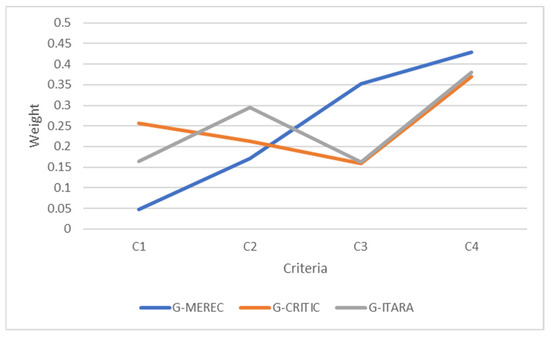
Figure 9.
Comparison of criterion weights (normalized center of grey weights) obtained by Grey ITARA, Grey CRITIC, and Grey MEREC for soil moisture sensor selection criteria.
In Figure 6, the criterion weights obtained by Grey ITARA, Grey CRITIC, and Grey MEREC for platform selection were compared to each other. While Grey ITARA and Grey CRITIC determine C2: Processing Power as the least important criterion, Grey MEREC identifies C3: Power Consumption as the least important criterion. C1: Cost is identified as the most important criterion using all three methods.
In Figure 7, the criterion weights derived from Grey ITARA, Grey CRITIC, and Grey MEREC for communication technology selection are compared. While criterion C1: Range is identified as the most significant factor by both Grey ITARA and grey CRITIC, Grey MEREC ranks criterion C3: Data Rate as the most important. Notably, criterion C2: Power Efficiency is consistently considered the least important across all three methods.
In Figure 8, the criterion weights derived from Grey ITARA, Grey CRITIC, and Grey MEREC for energy source selection are compared. Criterion C2: Cost is identified as the most important factor by both Grey ITARA and Grey CRITIC, whereas Grey MEREC ranks criterion C4: Sustainability as the most significant. Additionally, criterion C3: Maintenance is considered the least important by Grey ITARA and Grey CRITIC, while Grey MEREC identifies criterion C1: Availability as the least important.
In Figure 9, the criterion weights obtained by Grey ITARA, Grey CRITIC, and Grey MEREC for soil moisture sensor selection are compared. While criterion C1: Accuracy is identified as the least important by Grey MEREC, Grey ITARA and Grey CRITIC identify criterion C3: Durability as the least important. Additionally, criterion C4: Cost is recognized as the most important criterion by all three methods.
Figure 10, Figure 11, Figure 12 and Figure 13 present the final rankings of the alternatives using the Grey COBRA approach based on criterion weights obtained from Grey ITARA, Grey CRITIC, and Grey MEREC. These graphs illustrate how different weighting methods can lead to variations in the final rankings. In each graph, the vertical axis represents the rank of the alternative, while the horizontal axis corresponds to the numerical label assigned to each option. For instance, in the platform selection, PL1 is represented by the number 1, and in the soil moisture sensor selection, Sensor 3 is represented by the number 3.
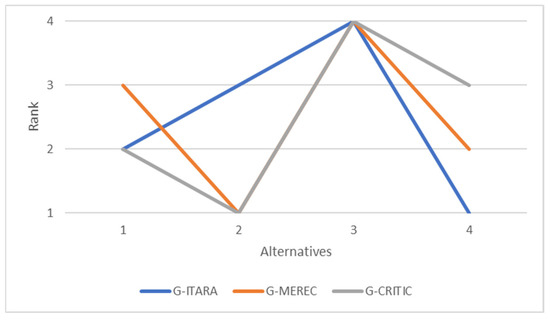
Figure 10.
Final rank of the alternatives using Grey COBRA based on weights obtained from Grey ITARA, Grey CRITIC, and Grey MEREC for platform selection.
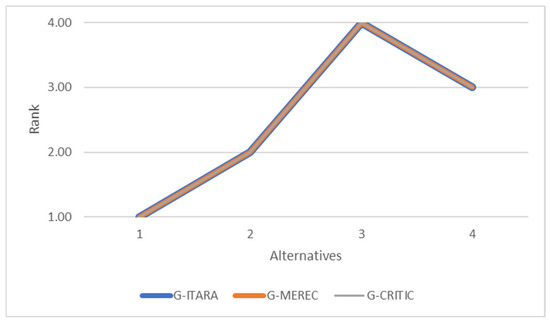
Figure 11.
Final rank of the alternatives using Grey COBRA based on weights obtained from Grey ITARA, Grey CRITIC, and Grey MEREC for communication technology selection.

Figure 12.
Final rank of the alternatives using Grey COBRA based on weights obtained from Grey ITARA, Grey CRITIC, and Grey MEREC for energy source selection.
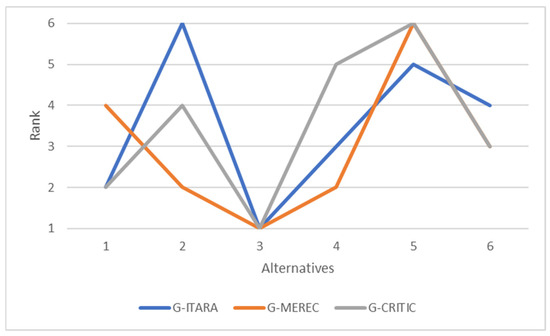
Figure 13.
Final rank of the alternatives using Grey COBRA based on weights obtained from Grey ITARA, Grey CRITIC, and Grey MEREC for soil moisture sensor selection.
Figure 10 shows the final ranks of alternatives for platform selection. Based on the weights obtained by Grey ITARA and Grey CRITIC, PL2 is ranked first. However, the weights obtained by Grey MEREC differ in the first rank. Based on Grey MEREC, PL4 is considered the first rank. All three weighting methods return weights in which PL3 ranks last.
As illustrated in Figure 11, based on all three weighting methods, the alternatives obtained similar rankings for communication technology selection. In these evaluations, Protocol 1 was selected as the best alternative and Protocol 2 as the worst alternative.
Figure 12 shows the final rank of the alternatives for energy source selection. As shown in this Figure, the weights of the Grey ITARA method select urban electricity as the top option (the reason for this is the high weight of cost based on the Grey ITARA method calculations), while the weights of the Grey MEREC and Grey CRITIC methods are such that they place Solar 1 in first place. Also, based on the weights obtained from the Grey MEREC and Grey CRITIC methods, urban electricity is in last place, and according to the Grey ITARA method, Solar 2 is in last place.
Figure 13 shows the final ranks of alternatives for soil moisture sensor selection. Based on the weights obtained by Grey MEREC and Grey CRITIC, Sensor 5 is ranked last. However, weights obtained by Grey ITARA differ in the last rank. Based on Grey ITARA, Sensor 2 is considered the last. All three weighting methods return weights in which Sensor 3 ranks first.
The differences in the rankings of alternatives based on different weights derived from the Grey ITARA, Grey MEREC, and Grey CRITIC methods show the significance of differences in weights derived from these methods. All three methods are classified as objective methods, but the effective point of the Grey ITARA method is the use of the indifference threshold concept. Given the presence of this factor in weighting, experts can determine the indifference threshold of each criterion. For example, experts assign more value to the indifference thresholds of the less important criteria. As a result, these criteria receive less weight. This method does not rely solely on the entropy of the data related to a criterion for weighting.
4. Discussion
In this study, we sought to design an expert system to select suitable hardware for IoT-based systems. Both expert opinions and product specifications are important in selecting these systems. Also, this expert system should be designed to automatically construct a decision matrix based on user needs announced from the user interface. In the introduction section, two questions were raised for this research, which are answered in this section.
- Q1
- : How can an expert system be designed to select the best hardware from the available alternatives?
There are generally three challenges in designing this system:
- Utilizing both expert knowledge and technical information.
- Understanding user needs.
- Existence of vague, unstructured data.
To overcome the first challenge, a knowledge engineering approach can be useful in designing this system. In this approach, expert knowledge should be stored in addition to technical product information. Therefore, this system has a database and a knowledge base.
For the second challenge, the user, through a user interface, inputs product specifications. These are derived from questions the system asks the user, and, as a result, the hardware components to be used are decided. The questions asked vary with different systems and must be designed by IoT system developers. The current approach, which tries to understand the user’s needs by asking a few questions, is very simplistic, and there is room for improvement. Using user feedback and training machine learning models based on big data can be useful in this regard.
Upon user feedback, the system recognizes relevant components and fetches suitable hardware configurations along with their corresponding data, criteria, and expert ratings from the system database and knowledge base.
To overcome the third challenge, the grey number approach can be used and combined with the ITARA and COBRA methods, which overlap with the second research question and will be addressed in the next section.
- Q2
- : Can the grey number approach be combined with the hybrid ITARA-COBRA method? How can this methodology help decision-makers?
In answer to the second question, this paper addresses the selection of hardware for IoT systems by solving several decision problems using a hybrid Grey ITARA-COBRA model. In this regard, the decision matrix is constructed from the database and the knowledge base, and the decision-making module ranks the alternatives based on expert-defined criteria.
In this approach, grey numbers are used to cover data with unknown exact values. For example, parameters such as sensor accuracy may not be known precisely. Also, the expert’s linguistic terms can be converted into grey numbers.
Since this approach allows for the use of both technical specifications and expert opinions, it is a suitable method for the engineering design of products. Using this method, existing engineering characteristics can be evaluated using both technical data and expert ratings.
Finally, the results of this study are comparable to those of other studies. In addition to presenting a grey method based on ITARA and COBRA that has the ability to handle unstructured and vague data that can be useful for engineering decision-making problems, this study proposes an architecture for an expert system that supports users in selecting appropriate hardware and designing hardware for IoT-based systems, which has not been seen in previous studies. Also, references [6,12,15,24] propose approaches for selecting hardware or IoT-based devices, but none of these presents a comprehensive system for selecting different hardware components from different parts of an IoT-based system. The system proposed in this study handles this task using technical data along with expert knowledge management.
5. Conclusions
This work presents an expert system architecture for hardware selection in IoT. For this problem, both expert knowledge and hardware specification data are needed. Moreover, the system should communicate with both the user and the expert. The proposed system includes a hardware specifications database, a knowledge base of expert-derived hardware ratings and selection criteria, and an interface to provide expert input and data capture.
In general, the architecture of this system is such that there are two types of interfaces: the user interface and the expert interface. Experts use their interface to enter information, such as their opinions, and users use the user interface and the questions the system asks them to enter their needs. These questions can vary from product to product. Expert ratings are entered into the knowledge base. There is also a database in the system where the technical specifications of the hardware are stored.
Next, the system, which has asked the user about his needs, extracts various hardware options that could be suitable for the user from the database. This hardware information, along with the experts’ scores and decision-making criteria, is given to the system’s decision-making engine to rank the options using the Grey ITARA-COBRA method. In this way, the designed expert system uses both expert ratings and technical specifications to rank the options. If experts have entered their opinions in response to the hardware selection for different systems, the proposed expert system can use the experts’ opinions for all these cases, and there is no need to fill out the questionnaire manually for each user.
The proposed Grey ITARA-COBRA method can be useful in several aspects. First, since grey numbers are utilized, parameters with unknown exact values are covered. Moreover, parameters with exact values can also be converted into grey numbers. It is worth mentioning that the verbal spectra of experts can also be converted into grey numbers.
The second point is that given the possibility of covering unstructured data by the ITARA method, it is possible to use both expert ratings and technical specifications. This makes it possible to use this approach in many engineering fields where both technical specifications and expert scores are used in decision-making.
Finally, it is worth mentioning that the ITARA method, which is used for weighting in the approach of this research, is a method that performs weighting based on both data entropy and the indifference threshold determined based on expert opinion. Considering these cases, both expert opinions and data entropy are effective in determining weights.
A sensitivity analysis reveals the effectiveness of this approach in dealing with unstructured and imprecise data. The sensitivity of the calculated weights to factors such as grey interval length, entropy, and the indifference threshold is investigated. As the grey interval length increases, the criterion weight decreases. Also, as expected, the criterion weight increases with increasing entropy and decreases with increasing indifference threshold.
Next, an example scenario was conducted to select the appropriate hardware for designing an IoT-based irrigation system. Initially, it was determined that the system required by the user needs an IoT platform, communication technology, an energy source, and a soil moisture sensor. Then, these alternatives were ranked based on the technical specifications and expert ratings.
In addition to the proposed methodology, weights were calculated using Grey MEREC and Grey CRITIC methods, and the comparisons show the impact of expert-defined indifference thresholds on criterion weights. In addition to these, the final rank of alternatives was calculated based on the Grey MEREC and Grey CRITIC methods and compared to the Grey ITARA method. The comparisons show the effect of utilizing the indifference threshold concept, and due to utilizing both entropy and indifference threshold concepts in addition to grey sets, the Grey ITARA method is preferred. Moreover, the Grey ITARA-COBRA method is proven to be effective and beneficial in the process of hardware selection. These cases confirm the hypothesis of this research, which is to determine the applicability of the Grey ITARA-COBRA method in engineering decision-making problems involving ambiguous unstructured data. The applicability of the Grey COBRA method in handling unstructured data is also confirmed because this approach was used to rank hardware based on ambiguous numerical data and expert opinions in this study. However, the presented approach is not totally perfect. In general, the main restrictions of the designed system are as follows:
- The absence of future-oriented scenarios in decision-making.
- Using a simplistic algorithm to understand user needs may result in misunderstandings.
- The system does not consider user ratings and user experiences when selecting components of IoT-based systems.
In addition, the limitations of this study were as follows:
- Lack of access to experts to evaluate a wide range of products, only examining the example of an IoT-based smart irrigation system.
- Limited availability of official technical data on hardware.
It is worth noting that with this approach, due to its ability to handle unstructured data, it is possible to use both expert opinions and technical specifications for decision-making. This feature makes the proposed approach a suitable method for evaluating products and selecting them with engineering specifications and expert opinions.
The following are suggested for future research:
- Extending the hybrid Grey ITARA-COBRA approach to other decision-making challenges.
- Investigating the utilization of fuzzy sets theory for problems with fuzzy datasets.
- It is possible to combine the ITARA method with subjective weighting methods to refine the weighting process.
- Considering user ratings to rank the alternatives.
- Developing a more sophisticated method to determine user needs. Training machine learning models is preferred.
- There is a possibility of increasing the efficiency of the IoT-based system that is being designed by considering its architecture in addition to hardware. In this regard, the system can be integrated with existing architectures. For example, Nikkilä et al. proposed an approach for information system management in precision agriculture [37]. Adopting such an approach can enhance the processes. Additionally, ensuring sustainable services and promoting user awareness and involvement in this domain can be beneficial [38]. Finally, improving the architecture to better incorporate contextual information can also be valuable [39].
Author Contributions
Conceptualization, T.A.P. and S.H.Z.; methodology, T.A.P. and S.H.Z.; software, T.A.P.; validation, T.A.P. and S.H.Z.; formal analysis, T.A.P. and S.H.Z.; investigation, T.A.P. and S.H.Z.; resources, T.A.P. and S.H.Z.; data curation, T.A.P.; writing—original draft preparation, T.A.P.; writing—review and editing, S.H.Z.; visualization, T.A.P.; supervision, S.H.Z. All authors have read and agreed to the published version of the manuscript.
Funding
This research received no external funding.
Institutional Review Board Statement
Not applicable.
Informed Consent Statement
Not applicable.
Data Availability Statement
The data presented in this study are available on request from the corresponding author.
Conflicts of Interest
The authors declare no conflicts of interest.
Abbreviations
The following abbreviations are used in this manuscript:
| MCDM | Multi-criteria decision-making |
| IoT | Internet of Things |
| ITARA | Indifference threshold-based attribute ratio analysis |
| COBRA | Comprehensive distance-based ranking |
| BWM | Best–worst method |
| AHP | Analytic hierarchy process |
| CRITIC | Criteria importance through inter-criteria correlation |
| MEREC | Method based on the removal effects of criteria |
References
- Savaglio, C.; Ganzha, M.; Paprzycki, M.; Bădică, C.; Ivanović, M.; Fortino, G. Agent-based Internet of Things: State-of-the-art and research challenges. Future Gener. Comput. Syst. 2020, 102, 1038–1053. [Google Scholar] [CrossRef]
- Zantalis, F.; Koulouras, G.; Karabetsos, S.; Kandris, D. A review of machine learning and IoT in smart transportation. Future Internet 2019, 11, 94. [Google Scholar] [CrossRef]
- Presciuttini, A.; Cantini, A.; Costa, F.; Portioli-Staudacher, A. Machine learning applications on IoT data in manufacturing operations and their interpretability implications: A systematic literature review. J. Manuf. Syst. 2024, 74, 477–486. [Google Scholar] [CrossRef]
- Adil, M.; Khan, M.K.; Kumar, N.; Attique, M.; Farouk, A.; Guizani, M.; Jin, Z. Healthcare Internet of Things: Security threats, challenges, and future research directions. IEEE Internet Things J. 2024, 11, 19046–19069. [Google Scholar] [CrossRef]
- Farooq, M.S.; Riaz, S.; Abid, A.; Umer, T.; Zikria, Y.B. Role of IoT technology in agriculture: A systematic literature review. Electronics 2020, 9, 319. [Google Scholar] [CrossRef]
- Silva, E.M.; Jardim-Gonçalves, R. Multi-criteria analysis and decision methodology for the selection of internet-of-things hardware platforms. In Proceedings of the Technological Innovation for Smart Systems: 8th IFIP WG 5.5/SOCOLNET Advanced Doctoral Conference on Computing, Electrical and Industrial Systems, DoCEIS 2017, Costa de Caparica, Portugal, 3–5 May 2017; pp. 111–121. [Google Scholar] [CrossRef]
- Tan, C.F.; Wahidin, L.S.; Khalil, S.N.; Tamaldin, N.; Hu, J.; Rauterberg, G.W. The application of expert system: A review of research and applications. ARPN J. Eng. Appl. Sci. 2016, 11, 2448–2453. [Google Scholar]
- Azaryoon, A.; Hamidon, M.; Radwan, A. An expert system based on a hybrid multi-criteria decision making method for selection of non-conventional machining processes. Appl. Mech. Mater. 2015, 735, 41–49. [Google Scholar] [CrossRef]
- Hatefi, M.A. Indifference threshold-based attribute ratio analysis: A method for assigning the weights to the attributes in multiple attribute decision making. Appl. Soft Comput. 2019, 74, 643–651. [Google Scholar] [CrossRef]
- Krstić, M.; Agnusdei, G.P.; Miglietta, P.P.; Tadić, S.; Roso, V. Applicability of industry 4.0 technologies in the reverse logistics: A circular economy approach based on comprehensive distance based ranking (COBRA) method. Sustainability 2022, 14, 5632. [Google Scholar] [CrossRef]
- Bitarafan, M.; Hosseini, K.A.; Zolfani, S.H. Identification and assessment of man-made threats to cities using integrated Grey BWM-Grey MARCOS method. Decis. Mak. Appl. Manag. Eng. 2023, 6, 581–599. [Google Scholar] [CrossRef]
- Xie, X.; Zhu, Q. Hardware-software partitioning of embedded systems using MCDM method. Appl. Res. Comput./Jisuanji Yingyong Yanjiu. 2014, 31, 1445–1448. [Google Scholar]
- Vasović, J.; Radojičić, M.; Vasović, S.; Nešić, Z. Multi-criteria Selection of the Computer Configuration for Engineering Design. Int. Arab J. Inf. Technol. (IAJIT) 2017, 14, 782–789. [Google Scholar]
- Garg, R.; Sharma, R.; Sharma, K.; Garg, R.K. MCDM based evaluation and ranking of commercial off-the-shelf using fuzzy based matrix method. Decis. Sci. Lett. 2017, 6, 117–136. [Google Scholar] [CrossRef]
- Chen, D.; Cong, J.; Gurumani, S.; Hwu, W.M.; Rupnow, K.; Zhang, Z. Platform choices and design demands for IoT platforms: Cost, power, and performance tradeoffs. IET Cyber-Phys. Syst. Theory Appl. 2016, 1, 70–77. [Google Scholar] [CrossRef]
- Stanujkić, D.; Jevtić, M.; Ivanov, B. An approach for laptop computers evaluation using multiple-criteria decision analysis. In Proceedings of the International Scientific Conference UNITECH 2018, Gabrovo, Bulgaria, 16–17 November 2018; pp. 263–267. [Google Scholar]
- Tsaryov, R.; Nikityuk, L. The method of selecting a hardware-software IoT-platform taking to account the factors of functionality and cost. Proc. O.S. Popov ONAT 2018, 1, 68–74. [Google Scholar] [CrossRef]
- Durão, L.F.; Carvalho, M.M.; Takey, S.; Cauchick-Miguel, P.A.; Zancul, E. Internet of Things process selection: AHP selection method. Int. J. Adv. Manuf. Technol. 2018, 99, 2623–2634. [Google Scholar] [CrossRef]
- Youssef, A.E. An integrated MCDM approach for cloud service selection based on TOPSIS and BWM. IEEE Access 2020, 8, 71851–71865. [Google Scholar] [CrossRef]
- Petrov, I. AHP enlargement in traditional Entropy-TOPSIS approach for selecting desktop personal computers for distance learning: Decomposition of evaluation criteria in blocks with AHP for better consideration of users’ needs in the MCDM process on the example of the Entropy-TOPSIS approach. In Proceedings of the 22nd International Conference on Computer Systems and Technologies, New York, NY, USA, 18–19 June 2021; pp. 61–66. [Google Scholar] [CrossRef]
- Tewari, N.; Deepak, N.; Joshi, M. Comparative study of IoT development boards in 2021: Choosing right hardware for IoT projects. In Proceedings of the 2021 2nd International Conference on Intelligent Engineering and Management (ICIEM), London, UK, 28–30 April 2021; pp. 357–361. [Google Scholar] [CrossRef]
- Pramanik, P.K.; Biswas, S.; Pal, S.; Marinković, D.; Choudhury, P. A comparative analysis of multi-criteria decision-making methods for resource selection in mobile crowd computing. Symmetry 2021, 13, 1713. [Google Scholar] [CrossRef]
- Mahdiabadi, S.E.; Eslami, S.; Eslami, H.; Hataminasab, S.H. Ranking cloud computing criteria in developing Electronic Communications Services using MCDM. Propósitos Y Represent. 2021, 9, 15. [Google Scholar] [CrossRef]
- Silva, E.M.; Agostinho, C.; Jardim-Goncalves, R. A multi-criteria decision model for the selection of a more suitable Internet-of-Things device. In Proceedings of the 2017 International Conference on Engineering, Technology and Innovation (ICE/ITMC), Madeira, Portugal, 27–29 June 2017; pp. 1268–1276. [Google Scholar] [CrossRef]
- Petrov, I. MCDM selection of laptops in TOPSIS: Criteria weighting with combined AHP and Entropy. In Proceedings of the 2022 Interdisciplinary Research in Technology and Management (IRTM), Kolkata, India, 24–26 February 2022; pp. 1–6. [Google Scholar] [CrossRef]
- Shiam, N.N.; Ibrahim, W.R. Ranking and Selection of the Best Laptop Model by Using Multiple Criteria Decision Making (MCDM) Methods. Proc. Sci. Math. 2022, 10, 189–199. [Google Scholar]
- Tomar, A.; Kumar, R.R.; Gupta, I. Decision making for cloud service selection: A novel and hybrid MCDM approach. Clust. Comput. 2023, 26, 3869–3887. [Google Scholar] [CrossRef]
- Karima Macharia, J. Selecting Cost-Effective Green Computing Approach for Server Virtualization Using FAHP-TOPSIS. Master’s Thesis, Near East University Institute of Graduate Studies, Department of Computer Information Systems, North Nicosia, Northern Cyprus, 2023. [Google Scholar]
- Gaur, A. Application of Grouped MCDM Technique for Ranking and Selection of Laptops in the Current Scenario of COVID-19. J. Inf. Technol. Manag. 2023, 15, 1–6. [Google Scholar]
- Sedighi Khavidak, S.; Hashemkhani Zolfani, S.; Nemati, A. Selection of portable hard disk drive using ENTROPY-COBRA-MARCOS-MAIRCA: A case of the Iranian market. Decis. Mak. Artif. Intell. Trends 2024, 1, 52–76. [Google Scholar] [CrossRef]
- Abdullah, A.G.; Shafii, M.A.; Pramuditya, S.; Setiadipura, T.; Anzhar, K. Multi-criteria decision making for nuclear power plant selection using fuzzy AHP: Evidence from Indonesia. Energy AI 2023, 14, 100263. [Google Scholar] [CrossRef]
- Leung, K.H.; Lau, H.C.; Nakandala, D.; Kong, X.T.; Ho, G.T. Standardising fresh produce selection and grading process for improving quality assurance in perishable food supply chains: An integrated Fuzzy AHP-TOPSIS framework. Enterp. Inf. Syst. 2021, 15, 651–675. [Google Scholar] [CrossRef]
- Haseli, G.; Sheikh, R.; Wang, J.; Tomaskova, H.; Tirkolaee, E.B. A novel approach for group decision making based on the best–worst method (G-bwm): Application to supply chain management. Mathematics 2021, 9, 1881. [Google Scholar] [CrossRef]
- Torkayesh, A.E.; Pamucar, D.; Ecer, F.; Chatterjee, P. An integrated BWM-LBWA-CoCoSo framework for evaluation of healthcare sectors in Eastern Europe. Socio-Econ. Plan. Sci. 2021, 78, 101052. [Google Scholar] [CrossRef]
- Dong, J.; Wan, S.; Chen, S.M. Fuzzy best-worst method based on triangular fuzzy numbers for multi-criteria decision-making. Inf. Sci. 2021, 547, 1080–1104. [Google Scholar] [CrossRef]
- Ulutaş, A.; Topal, A.; Pamučar, D.; Stević, Ž.; Karabašević, D.; Popović, G. A new integrated multi-criteria decision-making model for sustainable supplier selection based on a novel grey WISP and grey BWM methods. Sustainability 2022, 14, 16921. [Google Scholar] [CrossRef]
- Nikkilä, R.; Seilonen, I.; Koskinen, K. Software architecture for farm management information systems in precision agriculture. Comput. Electron. Agric. 2010, 70, 328–336. [Google Scholar] [CrossRef]
- Tseng, S.M.; Octavyaputri, S. Enhancing green service innovation behavior through green involvement: The role of information technology adoption. Aslib J. Inf. Manag. 2024. ahead-of-print. [Google Scholar] [CrossRef]
- Dospinescu, O.; Perca, M. Technological integration for increasing the contextual level of information. Analele Stiintifice Ale Univ. “Alexandru Ioan Cuza” Din Iasi-Stiinte Econ. 2011, 58, 571–581. [Google Scholar]
Disclaimer/Publisher’s Note: The statements, opinions and data contained in all publications are solely those of the individual author(s) and contributor(s) and not of MDPI and/or the editor(s). MDPI and/or the editor(s) disclaim responsibility for any injury to people or property resulting from any ideas, methods, instructions or products referred to in the content. |
© 2025 by the authors. Licensee MDPI, Basel, Switzerland. This article is an open access article distributed under the terms and conditions of the Creative Commons Attribution (CC BY) license (https://creativecommons.org/licenses/by/4.0/).